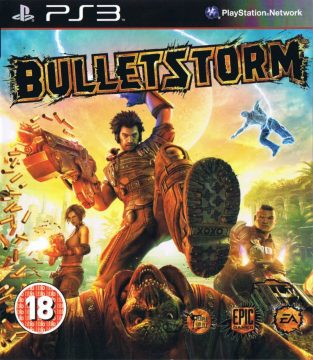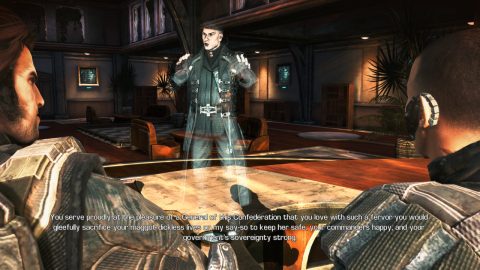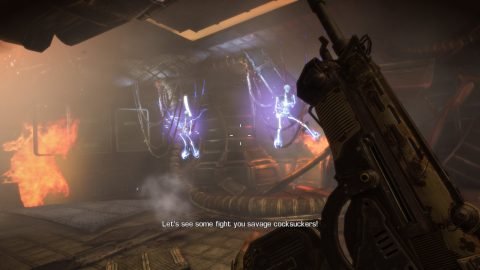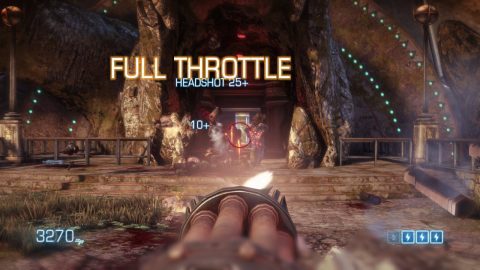
Bulletstorm is a project made by the combined efforts of Epic Games, future rulers of the industry, and People Can Fly, a far more interesting studio because they are the studio that made Painkiller, and thus cursed us all with the spread of various remnants of that franchise who will eventually outnumber us all. Painkiller is its own topic, but what’s important for now is understanding that it was one of the two franchises keeping the classic FPS spirit alive (Serious Sam the other), entirely without actually playing like a classic, but also not following modern trends. It would be a reoccurring thing for the developers of that series as they moved onto other things, and Bulletstorm was absolutely no exception. In fact, it may be most apt to compare it to another game made by former Painkiller devs – Shadow Warrior 2013.

For one thing, they have surprisingly strong stories for what was expected for these kinds of games, though they go at different angles for similar goals. Where Shadow Warrior (2013) was a character journey between two messed up people with a tragic twinge, Bulletstorm is a dark comedy tragedy mixed with deconstructive elements, commenting on the culture around FPS, then and what was now at the time. The villains are a uniform military organization run by a racist, homophobic drill sergeant of a general, who takes glee in war crimes and cruel violence. Our protagonist, Grayson Hunt, is someone with strong sense of right and wrong, but also solves his problems almost entirely with violence, acts entirely with anger and a bit of gleeful sadism at the chaos he causes, and ends up causing death and suffering for everyone around him.
Grayson and his squad, Dead Echo, were manipulated by General Sarrano into killing a long line of civilians who were considered a problem for Sarrano’s agenda, and Grayson responded by instantly going rogue, damning his entire squad without their consent. Years later, Grayson has become a space pirate with his old squad, then stumbles across Sarrano’s warship, attacks it, causes it to crash into a nearby planet, and gets pretty much the entire squad killed. The last remaining member besides Grayson is Ishi, who has been gerry-rigged to robot parts and his losing himself to an AI. Their last chance to survive is find Sarrano and hitch a ride on his escape pick-up, though that requires not killing the general. Things only get more complicated as they find a survivor of Sarrano’s current squad and explore a former resort destroyed by a nuclear disaster.

Bulletstorm‘s writing is a weird mixture of a genuinely good foundation hampered by its black comedy goals, as a lot of the comedy starts to revolve around how many cusses and private parts can be worked into a single sentence. It’s not out of nowhere with the pretty clear shots taken at Call of Duty and its toxic player base in there, but it’s often just a crutch for when the writers can’t think of a good line for a scene. Thankfully, the satire picks the right targets, aiming sights entirely on Capitalist systems and the military industrial complex, then using the absurdity of both to create cruelly comedic setpieces. The cultural commentary on The Gamers rings more hollow due to the game using some design norms from its targets, a similar problem Duke Nukem Forever had.
The game proper is based around racking up points with creative and skillful kills, and you get the tools for it. While the main arsenal is pretty standard (machine gun, a very good shotgun, handcannon, rocket launcher, ect), there are some fun flourishes. For example, you cannot shoot the sniper rifle in scoped mode without having a target highlighted by its interface, and then shooting slows time down so you can guide the bullet to the target or a completely different enemy (which can net a unique points bonus) a la the 2008 film Wanted. All weapons can also eventually get charges, special alt fires that usually hit harder or with a violent extra touch, like shooting flares that explode after a few seconds, or having remote detonation exploding bullets.
The real star is the leash, an energy whip like thing that you can summon from a device you get early in the campaign. It’s main use is drawing in enemies, which keeps them in a slow Dead Space style stasis for a short bit, long enough to set them up for stylish shooting or cruelty. You can also use kicks and a very fun slide kick for the same effect, all useful tools for knocking enemies into hazards, keeping up momentum, or setting up more complicated punishments.
When the game clicks, it’s a blast of chaos, wacky score titles popping up alongside explosions, gore, and gunfire. It’s quite thorough too, with points bonuses for the killing shot being in the butt, the crotch, managing to juggle, various environmental kill bonuses based on how the effect is activated, and so forth. The final stretch is some A-class FPS stuff just in terms of what fun you can have from your box of toys. The issue we run into is that Bulletstorm feels scared to fully be itself. If by publisher meddling, questionable creative direction, or some other unknown set of factors, the classic send up ends up using a lot of then modern FPS mechanics, and they clash against what the game is going for more often then not.
One major issue is that you are limited to three guns at a time, one of them having to be your boring starting machinegun (though its charge shot is very useful). Instead of a health bar, you have regenerating health that requires some time not being fired upon to kick in, and not every area gives you good cover if you need a breather. This is an issue due to how much of the enemy roster is hitscanners spraying invisible bullets at you and wearing you down, making a lot of play just slowing down the offensive with your leash. It might have been better off with hard bullets and a proper slo-mo mode, like in FEAR.
There’s also a heavy focus on setpieces, basic play often interrupted by spectacle moments that range from a fun distraction to an obnoxious short bit you have to go through to get back to the fun. They often portray really cool in concept bits, like blasting away bandits as a saucer rolls towards you, requiring you to redirect it from time to time. Actually playing these moments often comes down to an unmemorable turret section or a static and fairly boring shooting challenge that would have been better off as a cutscene.
This puts Bulletstorm in a weird space. These moments aren’t great for gameplay, making the experience of playing the game an awkward flow of highs and mediocrity. However, they do pace out the campaign’s narrative elements, and help balance out the funny and dramatic beats, making good transition points. A lot of these bits tend to come about due to Grayson doing something destructive to solve a problem, and that causing further problems, informing his character and creating some chuckles on the sly. In this context, a lot of them add to the whole, outside a small handful of time wasters that still feel significant alongside the short campaign length.
Further in the mixed bag is the game’s style, which can only truly be described as “seventh gen.” Brown wastelands, brown and green destroyed cityscapes, and a sprinkling of visually interesting urban ruins to act as backdrop for the array of effects that kick in when the violence starts. The music is effectively generic, solid action strings that really fit the scenes, but little else to stick in the mind. The sound effects range from impactful bombast to unsatisfying and downplayed gunfire. It looks and sounds like a forgettable Borderlands spinoff.
Bulletstorm got a graphically updated version called Full Clip Edition on PC, PS4, and Xbox One. The brilliant new addition is a post-campaign mode called Overkill Campaign, giving you access to all your toys from the start and introducing some new maps. For a game about creative killing, this is just a really smart move, not unlike Devil May Cry‘s bloody palace, or ULTRAKILL letting you replay any campaign level with your current arsenal. This version also got a DLC pack worked into the Switch version as a mode right from the start. That extra mode lets you play the game as Duke Nukem, played by Jon St. John, the joke being everything is exactly the same, except Duke has no idea why he’s here and just sort of goes along with it. It’s a dumb joke, but a funny one.
Otherwise, Bulletstorm‘s legacy seems to be Fox News blaming it and a handful of other games for increasing rape statistics (????????) and that’s just a shame. Hopefully that delayed sequel may happen one day (though Fortnite might make sure that never happens), because Bulletstorm has something unique to it, even compared to games that did its core ideas better (ie Shadow Warrior 2013). That unique blend of surprisingly sharp satire, likable unlikable characters, and wacky chaotic play could be done with some refining, to really bring out that promise, and maybe we’ll see that one day. Until then, what we have now is pretty alright, and worthy of a look if you consider yourself an FPS aficionado.


